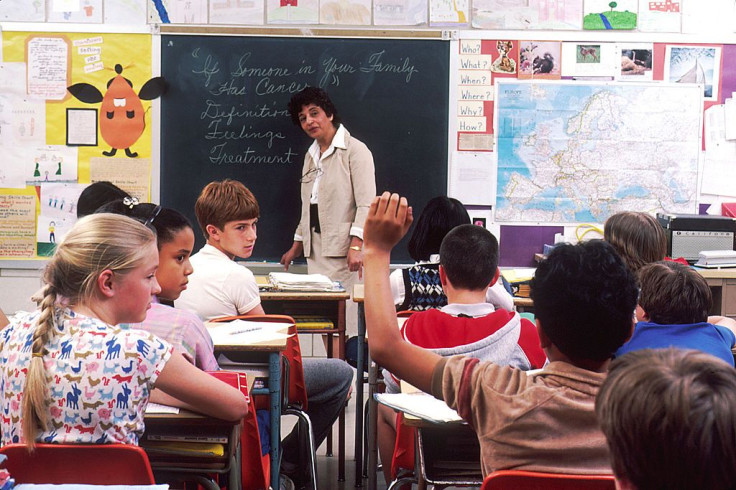Back-To-School Amid Coronavirus: How Pandemic Is Interfering With Annual Ritual

KEY POINTS
- Coronavirus disrupted the education of 56.6 million children in the spring, and it doesn't look like that disruption will end anytime soon.
- The CDC eased reopening guidelines, but both parents and teachers are uncomfortable with reopening school buildings as coronavirus cases surge across the country
- Trump is pushing for full reopening to get the economy to rev up
As President Trump and Education Secretary Betsy DeVos push to force schools to reopen fully in fall despite surging coronavirus cases, opposition is growing among parents and teachers.
They also wonder whether moving to online learning will further exacerbate the education gap between wealthier white students and minorities.
There are approximately 56.6 million students in elementary, middle and high schools across the country, 50.8 million in public schools and 3.7 million poised to begin attending prekindergarten. In a normal school year, parents begin rejoicing about now that summer break is coming to an end.
Experts have said there’s no way for the U.S. economy to come back completely without the reopening of schools to ease the burden of child care on parents.
Teachers, however, object.
“I feel the social pressure. However, I am not a child-care provider,” Nancy Ellis, a 55-year-old teacher in Santa Rosa, California, told Politico. “I have a master’s degree. Sorry, but I do not feel compelled to provide child care to ‘help the economy.’”
Teacher Katie Flaker was especially critical of DeVos.
“Kids aren't meant to be alone" – especially as orphans!” she tweeted.
An Associate Press-NORC poll indicates only 10% of Americans favor fully opening schools without restrictions and only 14% say just minor adjustments are necessary while nearly a third (31%) say there should be no in-person instruction. Three-quarters of teachers told a Gallup poll they were very or moderately concerned about returning to the classroom.
George Patterson, principal at Meyer Levin School in Brooklyn, New York, told International Business Times his district has strict limits when it comes to additional resources needed to safely reopen schools. He said schools are going to have to get creative to keep students engaged, especially with in-person classes only available part of the time.
“Our students are … going to be asked to step up and work in ways that will look very different from other years – and we're going to have to ask them to adapt quickly,” Patterson said, adding programs that offer culturally relevant material will be needed.
Rebecca Mannis, founder of Ivy Prep, noted students in middle-income families are particularly vulnerable to pressures created by keeping schools closed.
“Growing families, two-income homes, and those facing work-from-home realities have significant stressors that complicate learning for kids,” Mannis told IBTimes. “Parental burnout, job loss, family health issues and learning disorders like dyslexia cross all socioeconomic classes, so we must think deeply and systematically meet those directives in order to provide for all our deserving students and communities.
Trump last week again pushed for reopening.
“We cannot indefinitely stop 50 million American children from going to school, harming their mental, physical and emotional development,” he argued.
Many school districts are trying to develop hybrid programs providing in-school instruction for part of the week and online learning for the rest. In Kansas, the State Board of Education rejected an effort by Gov. Laura Kelly to delay the start of the school year despite rising case counts, saying there are rural areas unaffected by the virus.
The Centers for Disease Control and Prevention last week eased its guidelines for reopening after Trump objected the original guidelines were too strict and too expensive. The new guidelines were written by the White House, not public health officials.
Pollster Glen Bolger told the Chicago Tribune he has yet to see any data indicating the public is comfortable with pushing the issue now.
“It shows you how nervous Americans are about coronavirus,” he added. “Because let’s face it, virtual learning couldn’t be worse — yet large numbers of parents say, ‘We’re not putting our kids back in school.’”
A Kaiser Family Foundation poll indicated 60% of parents favor putting off opening school buildings until they can be assured infection risks are minimal.
Brad Johnston, co-founder and CEO of educational technology firm Tanoshi, said the situation likely will make the education gap between wealthy and poor students worse.
“Those living where the latest tech is not available will miss out on a wave of new skill development, and respective job opportunities, in tech and beyond. Low-income students, especially in low-income communities, don't today and will continue to not have the same opportunities as those from wealthy households and wealthy communities,” he told IBTimes.
Adryenn Ashley, CEO/PPE Supplies for COVID at Universal Services Foundation, said she home schooled her son for eight years and thinks students will benefit more from online instruction.
“The key is to organize school around your child's skill set. Focus on what they are good at, speed through what they hate. Also, school should not start before 10 a.m. These kids are already sleep-deprived. Let them wake up at 9 a.m.,” and take care of other bodily needs before buckling down, she said.
© Copyright IBTimes 2025. All rights reserved.






















